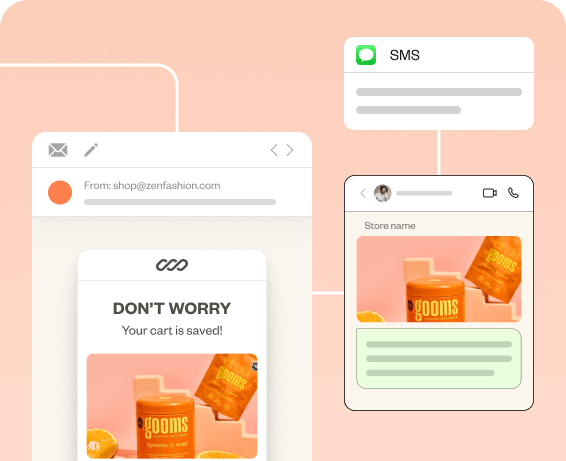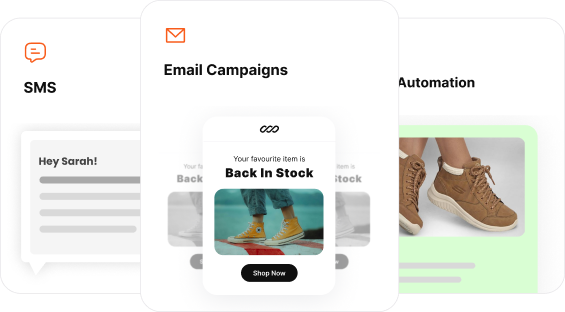How often do you actually open the emails in your inbox? Let’s be honest, it’s probably not that often. So, what makes you “open“? It’s simple: the emails that stand out are the ones with strong email branding, whether it’s through a great design or an offer that provides real value. It’s all about capturing attention and ensuring that every email you send resonates with your audience.
If you’re using email marketing as a primary channel, email branding is something you simply can’t overlook. It’s not just for growing eCommerce stores; even big brands like Sony, Nike, and others use personalized email branding to engage their audience and drive results.
If you are an ecommerce store owner, the moment your email appears on your customer’s screen, it should be hard to ignore. Something that makes them pause and click open. Whether it’s through visual appeal or a catchy subject line, something in it must catch their attention. Therefore, in this blog, you’ll learn how to brand your emails effectively and make them get opened every time.
Increase your email click-through rates by using personalized subject lines aligned with your branding strategy using Retainful’s AI subject line generator.
8 Essential Elements in Email Branding
As we mentioned, email branding involves utilizing several minor elements in an email. These elements are visual cues that show it is ‘you’ who is the sender, without letting the recipient second-guess. Here are the most important elements of email branding.
Let’s take the the email branding example of McDonalds.
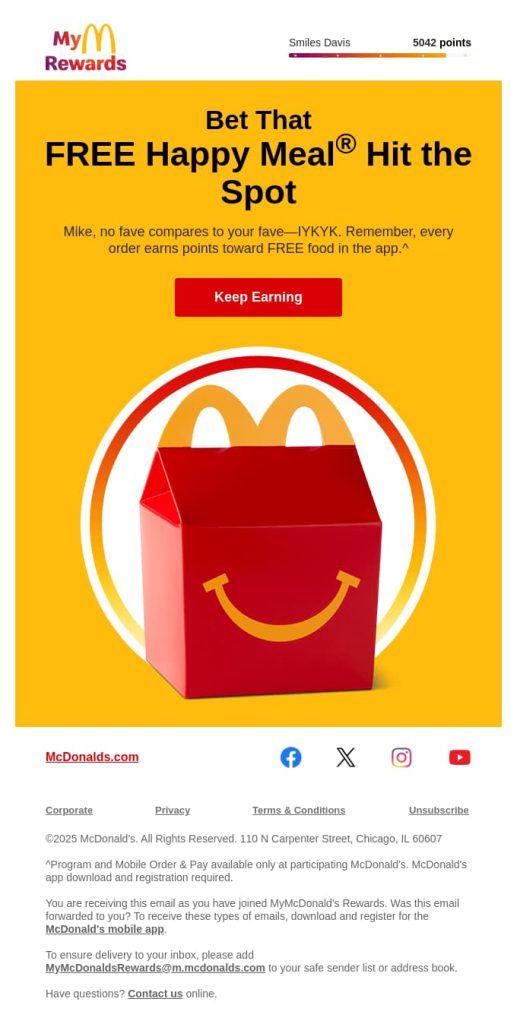
Brand Logo:
McDonald’s have placed their logo at the start near the “My Rewards” section. This instantly reinforces the brand through the iconic golden arches and signature red-yellow palette. In addition to that, you can also see the McDonalds logo at the center of the email template.
Color Tone:
Anyone can identify this one as a McDonald’s email from their iconic Red and Yellow color palette. Warm reds and yellows are proven to stimulate hunger and excitement. In addition to that, CTAs and key messages are paired with pop colors.
Typography:
Headings, sub-headings, and body text are differentiated by size and weight. Generous line-height and white space ensure the text is scannable on both desktop and mobile. Headline is set in a heavy-weight, uppercase font while sub-headings and CTAs are kept in regular-weight.
Tone of Voice:
By using the first name ( “Mike, no fave compares.. ), it sounds like a note from a friend, not a corporate memo, making the reader feel valued and included. Phrases like “Bet That FREE Happy Meal” convey excitement. The overall voice reinforces the joy of earning rewards and the anticipation of a free treat, which is a key to driving emotional connection.
Images:
The hero image which is a close-up shot of the Happy Meal Box, immediately communicates what rewards are on offer. The above points-meter doubles as a visual cue, with colored segments similar to sauce packers. These elements visually tie “earning” to a reward, making the mail both functionally and visually engaging.
Email Subject Lines:
“My Rewards”, “Your FREE Happy Meal is close!” immediately makes the email feel tailored and relevant as they are using personalized hooks with reward highlights. If you note the character count, it is around 40-60 characters, which is enough to display fully on mobile, yet descriptive enough to convey the values to the customers.
Email Layout &Signature:
The email layout is visually appealing with clear headers, a hero section, and a footer. And, for McDonald’s email signature, you can find its iconic golden arches or a simplified brand logo, reinforcing its brand identity all around.
Email Types Worth Branding
| TYPE OF EMAIL | BRANDING FOCUS | AUDIENCE_SPECIFIC TIP |
| Welcome Emails | Use visual consistency, warm tone, and introduce the brand. | Friendly tone, introduce brand values, and guide through the next steps. |
| Promotional Emails | Bold CTAs, product images, and urgency messaging. | Energetic tone for younger audiences or formal for luxury brands. |
| Abandoned Cart Emails | Persuasive tone, product images, and discount offers. | Personalize with product names and urgency to drive conversions. |
| Transactional Emails | Professional, clear layout with order details. | Focus on clarity, professional tone, and trust-building. |
| Newsletter Emails | Newsletter length, consistent layout, brand colors, and engaging content. | Informative tone for B2B or casual tone for lifestyle brands. |
| Re-engagement Emails | Friendly, inviting tone and personalized content. | Offer incentives like discounts or rewards to re-engage customers. |
| Feedback/Survey Emails | Clean, simple design with a polite and grateful tone. | Offer rewards for completing surveys and maintain a polite tone. |
| Event Invitation Emails | Event branding with an exciting tone and clear CTAs. | Focus on exclusivity and urgency for event participation. |
| Loyalty Program Emails | Highlight reward progress and personalized offers with visual consistency. | Motivate with rewards, personalized content, and a motivating tone. |
| Product Launch Emails | Use high-quality images with an exciting and exclusive tone. | Highlight product uniqueness and urgency to create excitement. |
Strategies in Email Branding
Approaching email branding strategically involves a combination of understanding your brand’s value, your audience preferences, and email design that reflects your brand identity. Here are some email branding strategies that you can incorporate into your business.
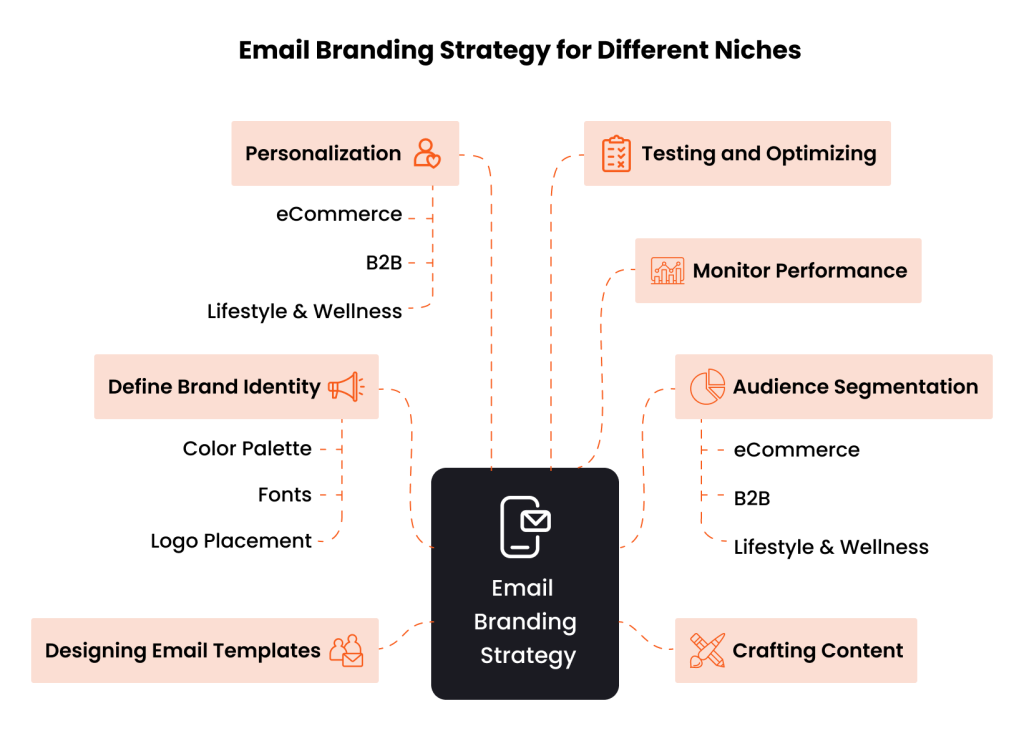
Approaching email branding strategically involves a combination of understanding your brand’s value, your audience preferences, and email design that reflects your brand identity. Here are some email branding strategies and best practices that you can incorporate into your business.
Step 1: Finding Your Email Branding Style
Finding the right style for your email branding ensures that your emails reflect your brand’s personality. It involves how it looks, how it feels to read, and what it communicates and making it align with your brand identity. Here’s how you find the right style.
- Brand Personality: What does your brand stand for? Are you a luxury brand or a fun, casual one? Your email tone should reflect the same personality that your customer associates with your brand. So, decide if your tone is formal, casual, playful, or authoritative and use language that matches it.
- Develop an Email Style Guide: Create a template that includes guidelines for logo placement, font, colors, and image use. Outline the specific tone and messaging approaches for various email types (Promotional, Welcome emails, etc). This ensures that anyone part of your business follows uniformity throughout.
- Adapt for Your Audience: Tailor the style for different audience segments. For example, a young audience may prefer a fun, casual tone, while a corporate audience might prefer a clean, professional style. So, segment your audience based on their behaviour, demography, etc.
Use ready-made email branding templates to maintain consistency in your email design and enhance your email branding and recognition using Retainful.
Step 2: Design Custom Email Templates That Work
Once you’ve found your style, you can start designing your email templates or redesigning your existing templates. While designing, ask yourself the following questions.
- Does the email template reflect our brand colors, logo, fonts, and overall style?
- Is the tone of voice consistent with other brand communications?
- Are the colors used in sync?
- Does the design look good on both desktop and mobile?
- Is there a visual hierarchy? Do users immediately know where to look first?
- Can the recipient easily navigate through the email and understand it?Are the buttons (CTAs, key messages) easy to spot and legible?
- Does the email layout support the primary goal of the email?
- Have you included necessary elements like unsubscribe links and privacy policies to comply with email marketing regulations?
Learn More: 10 Email Design Best Practices 2025
With these questions in mind, you can create templates that are effective tools for your email branding. No matter the direction you go with, keep everything consistent at all customer contact points.
If you aren’t a designer or want to cut short your work, use Retainful’s ready-made email templates, which you can customize to suit your brand.
Step 3: Include Content That Gets Attention
All of your email branding and design efforts will go in vain if it has generic content. Even an average Joe has an inbox filled with thousands of unopened emails. So, having attention-grabbing content ensures your emails stand out and get opened, driving conversions.
Learn More: 12 Actionable Strategies to Increase Email Open Rates
- Personalized Content: Start emails with the recipient’s name to create a more personal connection, along with tailoring the content based on past behaviour. For example, you can send like “Hi, (name), your favorite sneakers are back in stock! Complete your purchase before it runs out.” And, there are many more email personalization strategies, too, which you can apply.
- Creative Subject Lines: If your email subject lines aren’t catchy, brace yourself for a huge fall. So, get creative with your email subject lines that even a simple glance at it should tell them what it is.
- Tone of Voice: Keeping the content fun and lighthearted to your brand seem more approachable. It’s especially effective for lifestyle, fashion, or entertainment brands. On the other hand, a serious and professional tone can be used particularly for finance, law, and healthcare brands.
- Visual Appeal: Images, colors, layout, fonts, etc, are the visual elements in an email. Mix them up to create aesthetically pleasing emails that catch the customer’s attention as well as carry your brand tone.
Besides these, attach interactive elements such as GIFs, games, or even human elements such as videos featuring you or your employees. This makes your email more authentic.
Step 4: Email Brading Testing
Now, it’s time to find which emails work and fine-tune your email branding accordingly. For that, you need A/B testing, timing, frequency, etc.
- A/B Testing: Create more versions of emails and push out everything to find which works. By working, I mean that which gets clicks, actions, etc. This is what we call A/B testing. Experiment with subject lines, CTAs, design layouts, and email lengths, and find which one gets audience approval.
Learn More: 9 Great Call To Action Examples for Your e-Commerce Store
- Timing: People check their emails at different times. For instance, early morning might work for professional audiences, while evenings might work for personal, leisure-oriented products. The same goes for weekdays and weekends. So, identify your audience and test sending an email at 9 AM and another one in the afternoon (3 PM) to find which one gets responses.
- Mobile vs Desktop: Since 50% of emails are opened on mobile devices, ensure you adopt a ‘Mobile-first’ design approach. It means your emails must be able to adapt to different screen sizes.
By doing the above and tracking email marketing metrics, you can continually improve the effectiveness of your emails, ensuring they are not only visually aligned but also tailored to maximize engagement.
Step 5: Consistent Messaging
Consistency is all about sending emails at the right frequency. One week, you are sending emails every day, and the next, you’re just ghosting. This isn’t how you should function. Set a schedule and stick to it – no mood swings. Along with it, your emails should always match your brand’s signature style.
In this way, you can create a foundation for your email branding strategy, and it doesn’t end here. If one of your strategies doesn’t work, optimize it continuously to stay afloat, and also consider consulting with the leading branding agencies that specialize in building cohesive brands.
Best Email Branding Tools to Try
Here are some of the email branding tools you can try. Most of the tools in the table below offer all the essential features required to create your email brand.
| PLATFORM | BEST EMAIL BRANDING FEATURE | NO. OF TEMPLATES YOU CAN CREATE & RUN |
| Retainful | Customizable colors, fonts, and logo placement for abandoned cart and loyalty emails | Unlimited templates and run multiple campaigns simultaneously |
| Klaviyo | Advanced design editor with full control over colors, fonts, and branding elements | This email branding software comes with unlimited templates, run multiple campaigns with flexible segmentation |
| Canva | Fully customizable email designs with complete control over colors, fonts, and logos | Create and export unlimited templates, and integrate with email platforms for campaigns |
| Brevo | Drag-and-drop editor with the ability to adjust color schemes, font styles, and brand logos | Unlimited templates, email sends up to 100/day on the free plan, unlimited on paid plans |
| Moosend | Customizable branded templates with flexible color schemes and font styles | Unlimited templates, run multiple campaigns simultaneously |
| Stripo | Interactive email templates with full control over brand colors, fonts, and logo placement | Unlimited templates for email design branding, must integrate with an email service for running |
| MailerLite | Simple drag-and-drop editor with easy font and color customization for consistent branding through emails. | Unlimited templates, run multiple campaigns simultaneously |
How to Create Branded Emails Using Retainful
No matter how good a designer you are, you can’t match the consistency and speed offered by email branding tools with built-in email templates. Nowadays, all e-commerce businesses use ready-made email templates. Not just to cut short their work but also to maintain brand consistency and design throughout.
With email marketing tools such as Retainful, you can simply open the email template, drag-and-drop the elements you want to, and phew, it’s done. That’s how efficient it is.
Here’s a quick overview on how to do it using Retainful.
1. Go to your Retainful Dashboard and click “Campaigns.”
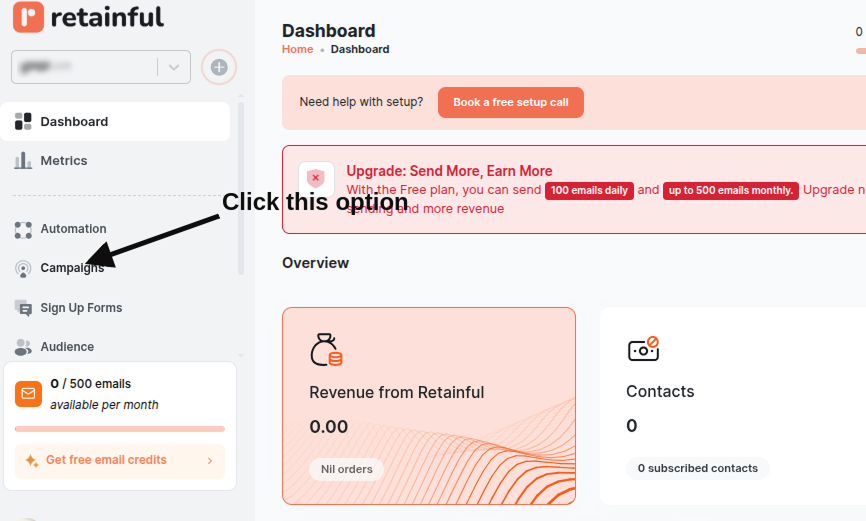
2. Select any of the existing email campaigns or click “+ Create campaign” to start a new one.
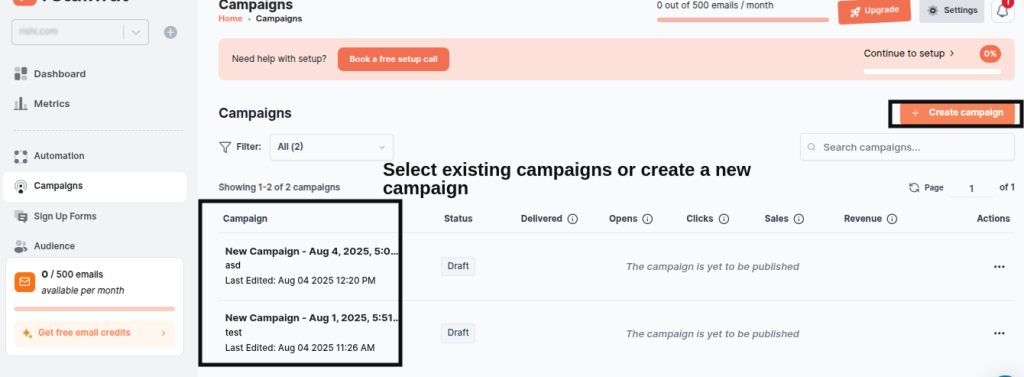
3. In the following screen, enter the sender and receiver details, subject lines, etc., and click “Continue to Content.”
4. Now is your ultimate step for “email branding” as you can find & select ready-made email templates for all categories, such as winback emails, feedback request emails, product recommendation emails, back in stock emails, etc.
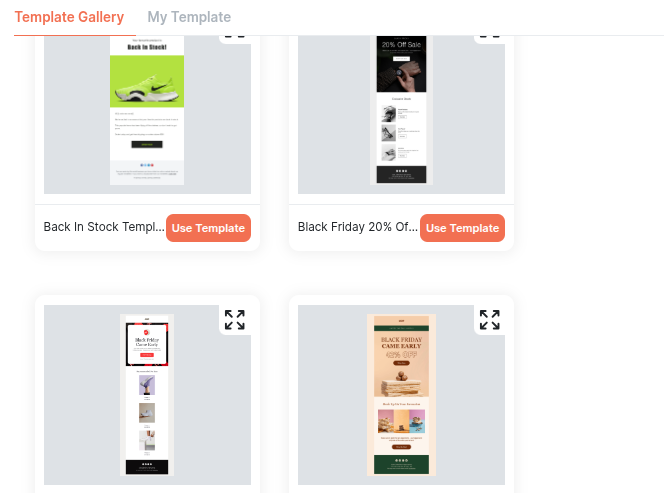
5. Start editing key email branding elements such as images, buttons, fonts, etc, with a simple drag and drop mechanism and save the template.
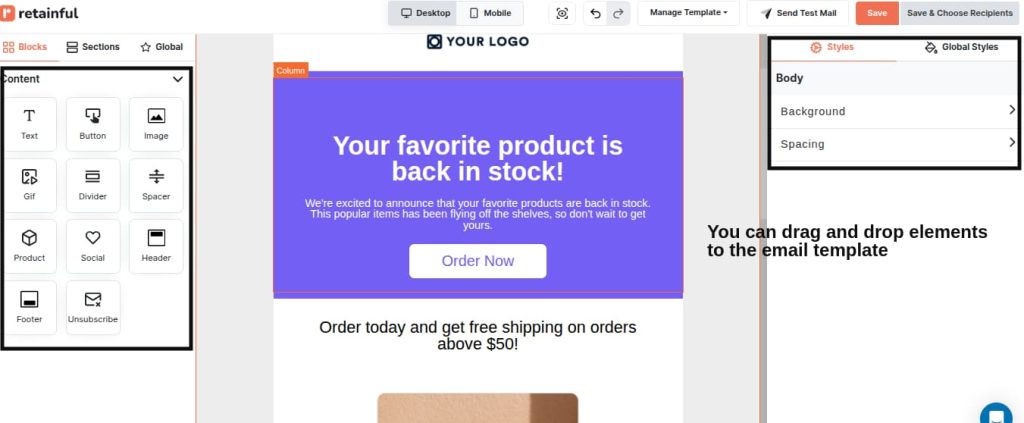
In this way, you can create your own branded email style using Retainful.
Challenges While Branding Your Emails
The entire process of branding through emails comes with its own set of challenges. Identifying these obstacles at the earliest and overcoming them will help you outrun your competitors and jump on your brand wagon earlier.
Here’s a table listing the challenges along with its solution.
| CHALLENGE | SOLUTION |
| Inconsistent Brand Identity Across Emails | Create a brand style guide and use email templates to ensure uniform branding. |
| Mobile-Friendly, responsive design emails | Use mobile-first design or responsive emails and test emails across devices to ensure responsiveness. |
| Low Engagement (Open & Click Rates) | Use A/B testing for subject lines, optimize content, and create compelling CTAs. |
| Time-Consuming Email Creation | Leverage pre-designed email templates for quicker setup and automate repetitive emails. |
| Personalization at Scale | Segment your audience and use dynamic content based on customer behavior and preferences. |
| Avoiding Spam Filters | Ensure clean email lists, avoid spammy language, and implement email authentication. |
| Managing Email Frequency and Over-Saturation | Segment your audience to send relevant emails at the right frequency based on customer engagement. |
| Deliverability Issues | Use email authentication (SPF, DKIM) and monitor sender reputation to improve deliverability. |
| Testing and Optimizing Performance | Use email testing tools such as Retainful and regularly A/B test emails to refine subject lines, content, and CTAs. |
| Designing for Different Audience Segments | Create targeted email campaigns and segment your list based on customer behavior and demographics. |
| Legal and Privacy Concerns | Follow GDPR and CAN-SPAM regulations, and include unsubscribe and privacy policies in every email. |
| Budget Constraints | Use email automation platforms with ready-made templates to reduce design costs. |
| Inadequate Email Testing Tools | Leverage email testing platforms like Litmus or Email on Acid to preview emails. |
| Lack of Brand Differentiation in Emails | Focus on unique visual elements and consistent messaging to stand out from competitors. |
| Managing High Volumes of Emails | Use email automation tools to streamline campaign management and reduce manual effort. |
Benefits of Email Branding in e-Commerce
Some of the convincing reasons why you should invest in email branding are mentioned below.
- Consistent email branding helps customers recognize your emails and gain trust, and boosts brand recall.
- Branded emails stand out, leading to increased email open rates by delivering targeted content.
- Professional emails, cohesive content enhance credibility and boost customer confidence in your brand.
- Using follow-up email templates that are branded encourage repeat purchases and keep your customers engaged.
- Having a strong email branding for your store helps you differentiate your brand and positions you as a leader in your industry.
From the above benefits, you can see that email branding extends beyond mere aesthetics. It ensures consistent communication, and ultimately drives higher conversions.
Easily refine your email branding strategy based on what works best, using analytics provided by Retainful.
Conclusion
This is all branding emails. Email branding is an essential yet overlooked part of email marketing strategies. While it’s not rocket science, it does require the right tools and strategies. With tools like “Retainful”, and the actionable strategies mentioned above, you can easily brand your emails and capture your customers’ attention.
However, remember that email branding is just one piece of your email marketing strategy. If something isn’t working, analyze where you’re falling short and adjust your approach.
Related Read:
- How to Measure Your Email Marketing ROI?
- How to Edit the WordPress Email Template? + Plugins
- Best Email List Building Tools to Increase Conversions
Frequently Asked Questions
An example of e-branding is Nike’s emails, which use consistent logos, colors, and tone to reflect their brand identity and create a memorable digital presence
Use ready-made or custom templates with your brand colors, fonts, and logo, ensuring consistency across all emails to strengthen your email branding. Ready-made email templates are available in email marketing platforms such as Retainful.
For corporate email branding, startups, entrepreneurs, or business emails, include personalized content, dynamic product suggestions, and tailored designs to match your audience’s preferences.
Follow email branding tips like consistent visuals, engaging subject lines, and personalized CTAs to capture attention and drive higher opens, clicks, and sales
